
Once all the disassembly and glue surface cleaning was complete I set to the task of making the pieces into a whole thing. Not precisely a whole long rifle, as that would imply functionality, but at least a whole assembly of the parts.

My first step in this process was to determine if the pieces actually all fit back together again without any modifications. Temporarily re-installing the barrel I decided that indeed the major elements fit nicely back together.
Since the configuration and shape of the rifle precluded my ability to really clamp anything together I used foam pads and wedges to hold everything in the precisely correct position and wicked-in some dilute hot hide glue into the break, just to hold things in place for what was to come next.
After allowing the glue to set fully overnight, I was delighted to pick up the rifle gently and realize that it stayed together. With the proper shape established I then wicked-in slightly diluted West System epoxy with extra slow hardener to allow it to wet out the gluing surfaces and voids completely. I let this sit for a week before touching it again.
Stay tuned.
***Apologia – somewhere I think I have a few more pictures of this process, but I either put them in the wrong directory or they are on a wandering SD card and have not been uploaded to my compewder yet. If I find them I will post them.***
Once Tim got all the metal parts removed from the rifle I was able to take a good look at what was inside. It was pretty much what I expected, based on my observations from the outside. The narrowest part of the rifle stock is also the region of the greatest stress from the explosion and reaction of the gunpowder igniting and expulsion of the heavy lead bullet. And when the material used for said stock is curly or highly figured there is a lot of end grain/short grain structure, so failure is a given.
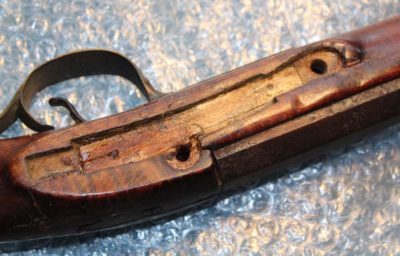
I could see immediately that the break was all the way through the narrow neck, and the only thing even holding it halfway was the inlet repair from days gone past (this picture was taken prior to the removal of the barrel). Even this repair was loose and shattered. At the very least, “the structural integrity was compromised,” as we say in our reports. As a matter of fact there were pieces already so loose that they were coming off n my bare hands.

There was no doubt that a complete disassembly was called for.

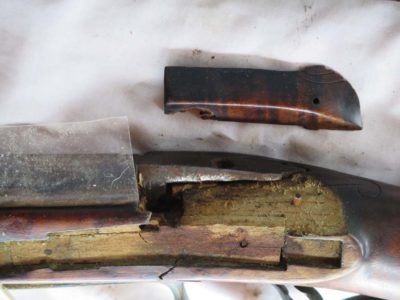
The initial “disassembly” was auto-started as one major piece came off without any help from me. It popped off when the barrel was detached in the initial disassembly.
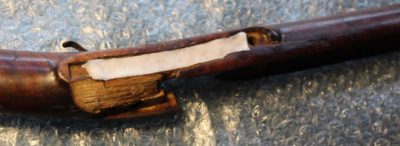
My first step was to remove the inset repair that was the last thing holding the rifle together. I poultice the area with water and 1% surfactant to soften the glue holding it all together.
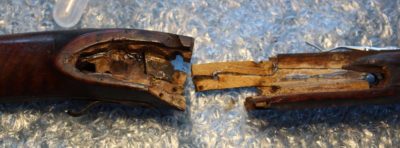
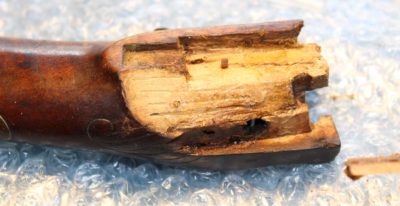
No sooner was that accomplished than the entire thing came apart. I now had direct access to all the gluing margins (and the glued that had been slathered/poured on in a previous restoration campaign).
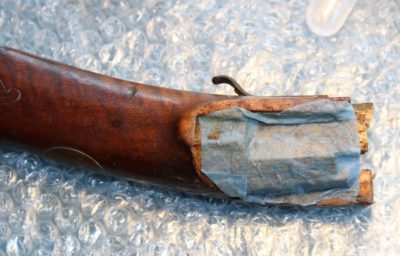
I poulticed and cleaned every surface I could get to, softening the glue and scraping it off with one of my home-made ivory tools, followed by swabbing with distilled water to get them squeaky clean.
I let eveything sit for a couple weeks to reach moisture equilibrium before beginning the reconstruction.
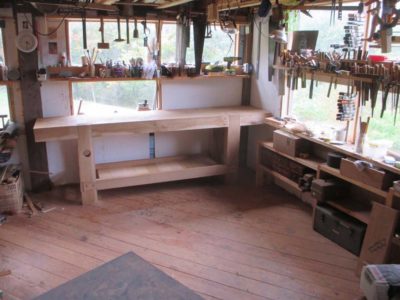
Usually I find that hindsight is somewhere in the range of 20/20. When I moved my FORP bench into the studio I though I had the perfect location for it. It sure looked great there, at least until the space got put back together.
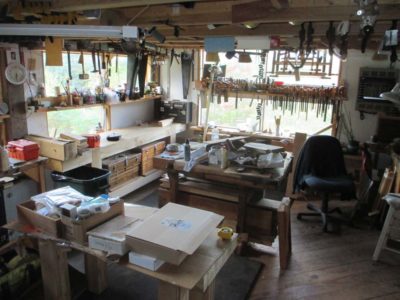
After almost two years of using it there I have become less enamored with the situation.

For starters I rely more on my original small torsion box bench more than anything else, in great part because of the vises already up and running on it. The spatial relationship between my favorite bench and the FORP bench has precluded my finishing and installing the leg vise on the FORP, knowing that if I did install the leg vise the tight quarters would result in me cracking my knee on a regular occasion, resulting in improper verbal outbursts.

After cogitating on the issue for several months I recalled how much I enjoyed having my first Roubo bench in front of the eastern windows before I moved it to the finishing station twenty feet away.
Now I think I know what to do.
















Recent Comments